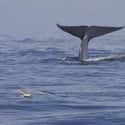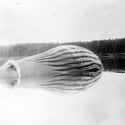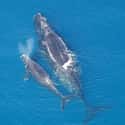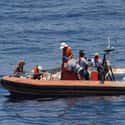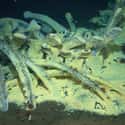-
(#1) The Whale Passes Away
Whales have an incredibly long lifespan; depending on the species, they can live for over 100 years. However, that life can be cut short by humans. Fishing, accidents, and pollution cause a large percentage of whale deaths.
Of course, whales can pass from natural causes, too. They may succumb to old age, or fall victim to their own bodies. Whales are susceptible to parasites, and they can cause fatal problems.
-
(#2) Decomposition Begins Immediately
After death, a whale's body begins to break down. Cell tissue deteriorates, bacteria from inside and outside of the body begins to eat away at the tissues and liquefy organs, and fermentation occurs.
The entire decomposition phase causes a build-up of byproducts and noxious gases within the whale.
-
(#3) Gasses Accumulate Inside The Body
The noxious gasses created during the whale's decomposition create airy pockets of CO2, methane, hydrogen sulfide, and ammonia within its body. This causes the whale to bloat dramatically, and builds very intense pressure - an estimated three to five atmospheres of it, in fact.
Often, the gas slowly leaks out through weak points in the whale's tissue, but it can also linger for some time.
-

(#4) The Body Might Float On The Water's Surface
Sometimes, the gas build-up in the whale's body can cause it to become buoyant. As long as the gas remains, the body will continue to float along the surface of the water. That makes it an easy target for scavenging fish and birds, who will begin to pick flesh off the body.
-
(#5) The Whale Could Explode
The gaseous pressure that builds up inside a whale's body can actually cause the corpse to explode. The vented gas can propel organs and other bodily waste out of the body at extreme speeds, covering anything nearby with flesh and viscera.
-
(#6) It Becomes A Whale Fall
As bloating in the whale subsides, the body begins to slip beneath the surface, creating a "whale fall." The term refers to the body that is now drifting toward the ocean floor. If this occurs in the shallows, scavengers will prey upon the body almost immediately, and the warm waters will greatly speed up the decomposition process.
However, in deeper waters, the deceased whale decomposes at a slower rate. The body might sink all the way to the bottom before losing much of its flesh.
-
(#7) Roaming Scavengers Strip The Carcass
While the whale's body still has meat, a colorful array of scavengers will pick its bones clean. The vast corpse provides food for animals like sleeper sharks and hagfish. On average, these hungry wandering fish will eat hundreds of pounds of meat from the whale per day.
They can strip the body bare within a few months, though larger whales might take a few years to consume.
-
(#8) Scientists Sometimes Get In On The Action
A completely different type of scavenger a whale's body might encounter: scientists. The scientific community still doesn't know that much about whales, as they live in some of the deepest parts of the oceans and are extremely mobile. Whale carcasses give scientists a chance to take get samples for further study.
These necropsies help scientists understand the living versions of whales - data that would be nearly impossible to get otherwise.
-
(#9) Animals Inhabit And Eat The Skeleton
Once the whale is nothing more than a skeletal frame, animals known as "enrichment opportunists" swoop in. Crustaceans and bivalves begin settling in the areas around the bones, enjoying a newfound territory made inhabitable by the work of the previous scavengers. This process can take up to 18 months.
-
(#10) Bacteria Breaks Down The Bones' Lipids
Whale bones contain a high amount of lipids. In fact, lipids make up about four to six percent of a whale's body weight. As the whale's body is stripped by scavengers, bacteria take on those lipids. As the microorganisms break down the bones, they produce hydrogen sulfide, ridding it of many of the previous inhabitants.
This phase can take a decade or more to complete.
-
(#11) Hydrogen Sulfide Attracts New Creatures
The amount of hydrogen sulfide produced by bacteria during this stage attracts particular species of animals that feed off the chemical. Mussels, clams, limpets, and sea snails all start to make their home around the whale's body due to the abundance of these bacterial mats.
-
(#12) A Thriving Community Develops
When a whale sinks to the bottom of the ocean floor, it can sustain an ecosystem similar to that of a deep sea vent for decades, and even centuries. This final phase is called the reef stage, and it's something of a mystery to researchers.
However, experts theorize that a large whale's bones could be sturdy enough to continue to support life long after the rest of the carcass is gone.
New Random Displays Display All By Ranking
About This Tool
Whale Fall refers to the phenomenon that a dead whale sinks to the bottom of the sea. The carcass of a whale can support a circulatory system dominated by decomposers for a hundred years. This phenomenon, hydrothermal and cold springs are called the oasis of life in the deep sea. The dead whale occupies an important position in the marine ecosystem, and the whale fall ecosystem can be divided into 4 stages of evolution.
The formation and disappearance of whale falls are long for many creatures. The random tool introduced 12 details about what happens when dead whales sink into the deep ocean. The number of existing whale falls is much smaller than in the past. Some specific populations, such as gray whale populations, only have poor double-digit numbers in the Western Pacific.
Our data comes from Ranker, If you want to participate in the ranking of items displayed on this page, please click here.










